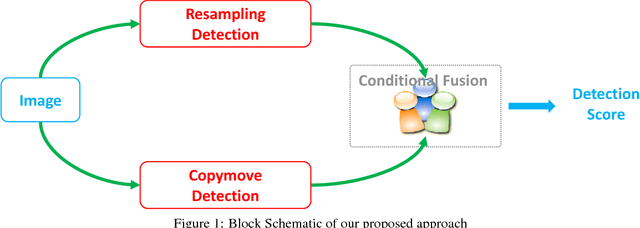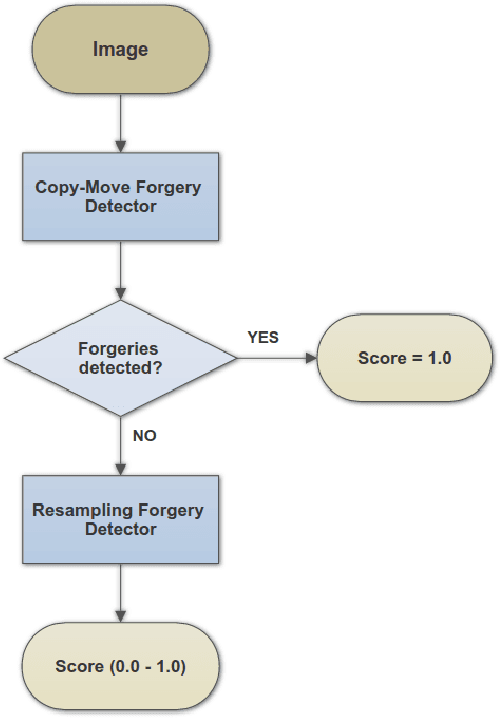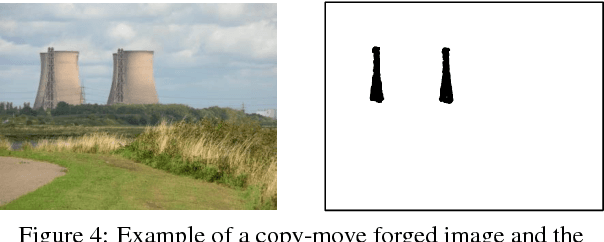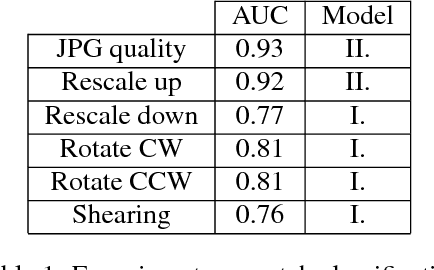Lawrence Peterson
Resampling Forgery Detection Using Deep Learning and A-Contrario Analysis
Mar 01, 2018



Abstract:The amount of digital imagery recorded has recently grown exponentially, and with the advancement of software, such as Photoshop or Gimp, it has become easier to manipulate images. However, most images on the internet have not been manipulated and any automated manipulation detection algorithm must carefully control the false alarm rate. In this paper we discuss a method to automatically detect local resampling using deep learning while controlling the false alarm rate using a-contrario analysis. The automated procedure consists of three primary steps. First, resampling features are calculated for image blocks. A deep learning classifier is then used to generate a heatmap that indicates if the image block has been resampled. We expect some of these blocks to be falsely identified as resampled. We use a-contrario hypothesis testing to both identify if the patterns of the manipulated blocks indicate if the image has been tampered with and to localize the manipulation. We demonstrate that this strategy is effective in indicating if an image has been manipulated and localizing the manipulations.
Boosting Image Forgery Detection using Resampling Features and Copy-move analysis
Feb 19, 2018



Abstract:Realistic image forgeries involve a combination of splicing, resampling, cloning, region removal and other methods. While resampling detection algorithms are effective in detecting splicing and resampling, copy-move detection algorithms excel in detecting cloning and region removal. In this paper, we combine these complementary approaches in a way that boosts the overall accuracy of image manipulation detection. We use the copy-move detection method as a pre-filtering step and pass those images that are classified as untampered to a deep learning based resampling detection framework. Experimental results on various datasets including the 2017 NIST Nimble Challenge Evaluation dataset comprising nearly 10,000 pristine and tampered images shows that there is a consistent increase of 8%-10% in detection rates, when copy-move algorithm is combined with different resampling detection algorithms.
Detection and Localization of Image Forgeries using Resampling Features and Deep Learning
Jul 03, 2017



Abstract:Resampling is an important signature of manipulated images. In this paper, we propose two methods to detect and localize image manipulations based on a combination of resampling features and deep learning. In the first method, the Radon transform of resampling features are computed on overlapping image patches. Deep learning classifiers and a Gaussian conditional random field model are then used to create a heatmap. Tampered regions are located using a Random Walker segmentation method. In the second method, resampling features computed on overlapping image patches are passed through a Long short-term memory (LSTM) based network for classification and localization. We compare the performance of detection/localization of both these methods. Our experimental results show that both techniques are effective in detecting and localizing digital image forgeries.
 Add to Chrome
Add to Chrome Add to Firefox
Add to Firefox Add to Edge
Add to Edge